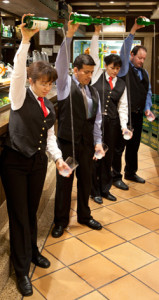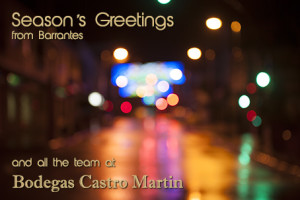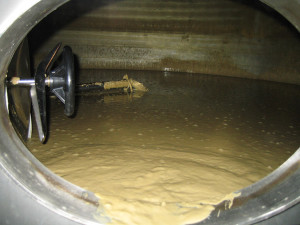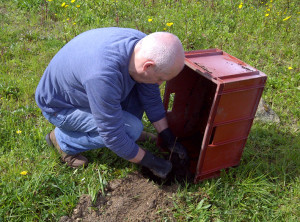 We have just returned from a couple of days visiting a distributor in Asturias, our neighbouring Province just east of us, along the northern coast of Spain. With it’s lush green pastures it is known as the nation’s capital of beef and dairy produce which includes an impressive selection of regional cheeses. It is however, also famous for another product, perhaps a little more closely related to our own….. apple cider. I should start by saying that this is nothing to do with the ‘refined’ sparkling, sometimes sweet, cider that is consumed in other parts of the world. This natural cider is flat, opaque, acidic and nearly always completely dry. Sounds delicious!
We have just returned from a couple of days visiting a distributor in Asturias, our neighbouring Province just east of us, along the northern coast of Spain. With it’s lush green pastures it is known as the nation’s capital of beef and dairy produce which includes an impressive selection of regional cheeses. It is however, also famous for another product, perhaps a little more closely related to our own….. apple cider. I should start by saying that this is nothing to do with the ‘refined’ sparkling, sometimes sweet, cider that is consumed in other parts of the world. This natural cider is flat, opaque, acidic and nearly always completely dry. Sounds delicious!
The same as our own albariño, the production of cider in Asturias is strictly controlled by its very own Denomination of Origin, which dictates not only how it is produced, but also the list of approved apples that can be used. This natural cider is bottled in spring each year and usually varies between 4% and 6% alcohol.
The ‘Siderias’ or cider bars where this traditional beverage is served are instantly recognisable by the odour of apple juice that hits you the moment you step in through the door. Of course this could be something to do with the way it is ‘thrown’ into the glasses. Once you uncork a bottle of natural cider it has to be finished in one sitting as, like the apple itself, the juice will oxidise very quickly, but then the way it is served is quite unique.
Natural cider is flat and has to be aerated, this is done by ‘throwing’ the juice into the glass from a distance – in other words pouring it from a height of about one or two metres. This might appear to be just a bit of showmanship but it does actually carbonate the cider and adds to the bouquet. The downside of this process is that by pouring the liquid from such a distance when it hits the glass it simply splashes everywhere, and, as a result, the floors of the Siderias are always damp with a covering of juice. Also, if there is any deposits in your glass, then you can either consume them or simply dump them out on the floor – some Siderias have special drains for this and that’s why a Sideria has such a strong odour when you first walk in.
 We have just returned from a couple of days visiting a distributor in Asturias, our neighbouring Province just east of us, along the northern coast of Spain. With it’s lush green pastures it is known as the nation’s capital of beef and dairy produce which includes an impressive selection of regional cheeses. It is however, also famous for another product, perhaps a little more closely related to our own….. apple cider. I should start by saying that this is nothing to do with the ‘refined’ sparkling, sometimes sweet, cider that is consumed in other parts of the world. This natural cider is flat, opaque, acidic and nearly always completely dry. Sounds delicious!
We have just returned from a couple of days visiting a distributor in Asturias, our neighbouring Province just east of us, along the northern coast of Spain. With it’s lush green pastures it is known as the nation’s capital of beef and dairy produce which includes an impressive selection of regional cheeses. It is however, also famous for another product, perhaps a little more closely related to our own….. apple cider. I should start by saying that this is nothing to do with the ‘refined’ sparkling, sometimes sweet, cider that is consumed in other parts of the world. This natural cider is flat, opaque, acidic and nearly always completely dry. Sounds delicious!
The same as our own albariño, the production of cider in Asturias is strictly controlled by its very own Denomination of Origin, which dictates not only how it is produced, but also the list of approved apples that can be used. This natural cider is bottled in spring each year and usually varies between 4% and 6% alcohol.
The ‘Siderias’ or cider bars where this traditional beverage is served are instantly recognisable by the odour of apple juice that hits you the moment you step in through the door. Of course this could be something to do with the way it is ‘thrown’ into the glasses. Once you uncork a bottle of natural cider it has to be finished in one sitting as, like the apple itself, the juice will oxidise very quickly, but then the way it is served is quite unique.
Natural cider is flat and has to be aerated, this is done by ‘throwing’ the juice into the glass from a distance – in other words pouring it from a height of about one or two metres. This might appear to be just a bit of showmanship but it does actually carbonate the cider and adds to the bouquet. The downside of this process is that by pouring the liquid from such a distance when it hits the glass it simply splashes everywhere, and, as a result, the floors of the Siderias are always damp with a covering of juice. Also, if there is any deposits in your glass, then you can either consume them or simply dump them out on the floor – some Siderias have special drains for this and that’s why a sideria has such a strong odour when you first walk in.
 Firstly, and most importantly, we simply want to thank all our friends and customers most sincerely for their continued support during 2016. This is without doubt, the very best gift that we receive each year.
Firstly, and most importantly, we simply want to thank all our friends and customers most sincerely for their continued support during 2016. This is without doubt, the very best gift that we receive each year.







